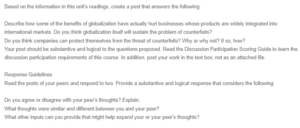Counterfeiting and the Global Marketplace
Describe how some of the benefits of globalization have actually hurt businesses whose products are widely integrated in international markets. Do you think globalization itself will sustain the problem of counterfeits?
Globalization has been beneficial to a lot of businesses in many ways. Due to globalization, many businesses now have developed supply chains in several countries that allow them to produce products at cheaper costs (Chow, 2010). Their distribution channels have also been developed in a way that makes access to products easier and more convenient for the target consumers. However, the diversified supply chain means that the businesses have numerous third-party distributors. Having so many distributors in the market exposes businesses to the risk of counterfeiting. The sellers of the products have a decreased chance of knowing whether what they are selling comes from the real manufacturer or from a counterfeit company. The deep integration into the international markets makes it easier for counterfeit manufacturers to inject their counterfeit products into the real company’s supply chain. Need help with your assignment ? Reach out to us. We offer excellent services.
Additionally, the globalization strategies that a lot of businesses use increase the customers’ chances of choosing counterfeits willingly. A lot of businesses today take advantage of globalization to produce their products in places where the cost of production is minimized. This is usually true in third-world countries where the minimum wage is very low. Such globalization business models enable the buyers of products to easily choose counterfeits, which are perceived to have the same or better quality than real products in some cases (Roudaut, 2012). For instance, in the past, one would buy a designer handbag because it was custom-made in a first-world country. Today, such products are expensive but made in the same way that the cheaper options are made.
Therefore, the only way globalization itself can sustain the problem of counterfeiting is if businesses rethink their global strategies. Businesses must design their global supply chains in a way that does not diminish the perceived quality of their products. Additionally, the supply chain should be designed in a way that minimizes the risk of counterfeit products being mistaken for real ones.
Do you think companies can protect themselves from the threat of counterfeits? Why or why not? If so, how?
Although counterfeiting is a major problem, there are ways that businesses can protect themselves from the threat of counterfeits. One of the ways to achieve this is to take advantage of what technology has to offer. There are ways in which businesses can use verifiable codes to enable easy identification of counterfeits in the market (Miller, Meraglia, & Hayward, 2012). A lot of businesses are already doing this to protect their customers. Customers can search the internet to verify the validity of a product’s code before they make a purchase. Businesses can also reduce this risk by actively pursuing counterfeiters. The law gives businesses the right to protect their intellectual property. Actively pursuing counterfeit businesses can be a good strategy to discourage people from starting such businesses. Businesses can also try to have authorized dealers for their products. Consumers should be encouraged to buy products only from retailers who have been authorized by the company.
References
Chow, D. (2010). Counterfeiting as an Externality Imposed by Multinational Companies on Developing Countries. Va. J. Int’l L., 51, 785.
Miller, M., Meraglia, J., & Hayward, J. (2012). Traceability in the age of globalization: A proposal for a marking protocol to assure authenticity of electronic parts (No. 2012-01-2104). SAE Technical Paper.
Roudaut, M. R. (2012). From sweatshops to organized crime: the new face of counterfeiting. In Criminal Enforcement of Intellectual Property. Edward Elgar Publishing.
ORDER A PLAGIARISM-FREE PAPER HERE
We’ll write everything from scratch
Question

Counterfeiting and the Global Marketplace
Based on the information in this unit’s readings, create a post that answers the following:
Describe how some of the benefits of globalization have actually hurt businesses whose products are widely integrated into international markets. Do you think globalization itself will sustain the problem of counterfeits?
Do you think companies can protect themselves from the threat of counterfeits? Why or why not? If so, how?
Your post should be substantive and logical to the questions proposed. Read the Discussion Participation Scoring Guide to learn the discussion participation requirements of this course. In addition, post your work in the text box, not as an attached file.
Response Guidelines
Read the posts of your peers and respond to two. Provide a substantive and logical response that considers the following:
Do you agree or disagree with your peer’s thoughts? Explain.
What thoughts were similar and different between you and your peer?
What other inputs can you provide that might help expand your or your peer’s thoughts?

